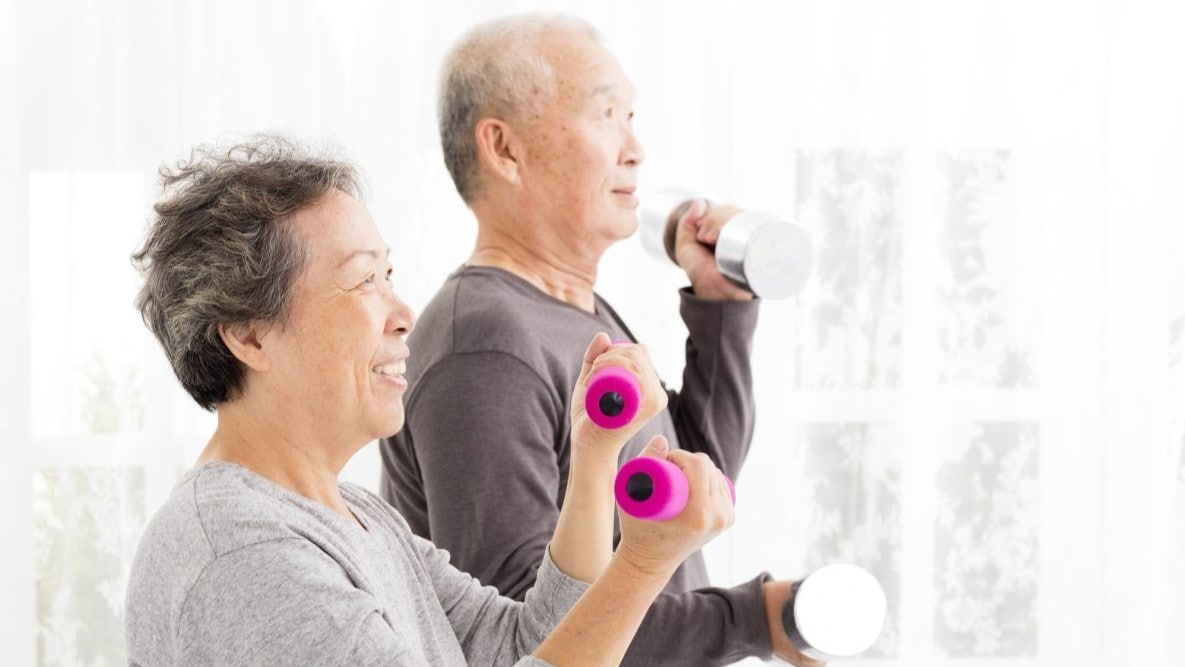Key points
- Adults 65 or older need a mix of aerobic, muscle-strengthening, and balance activities each week.
- A variety of activities can be included in each of these categories.
- Some activities include a combination of all three types.

Aerobic activity

Older adults need 150 minutes of moderate-intensity aerobic physical activity each week, which is equivalent in effort to brisk walking. This could be 30 minutes a day, 5 days a week. Or, to meet recommendations, older adults could get 75 minutes a week of vigorous-intensity aerobic physical activity, which is equivalent in effort to running or jogging. Or they could get an equivalent combination of moderate- and vigorous-intensity physical activity. Read more about physical activity intensity.
Aerobic physical activity or "cardio" is rhythmic and continuous. It gets you breathing harder and your heart beating faster. Try a few of these activities:
- Mow the lawn or rake the leaves.
- Learn a new dance.
- Walk to the store.
- Hike a trail.
- Do active forms of yoga (such as Vinyasa or power yoga).
- Ride a bike inside or outside.
- Join a water aerobics class.
Measuring intensity
On a 10-point scale, where sitting is 0 and working as hard as you can is 10, moderate-intensity aerobic activity is a 5 or 6. It will make you breathe harder and your heart beat faster. You'll also notice that you'll be able to talk, but not sing the words to your favorite song.
Vigorous-intensity activity is a 7 or 8 on this scale. Your heart rate will increase quite a bit, and you'll be breathing hard. You won't be able to say more than a few words without stopping to catch your breath.
You can do moderate- or vigorous-intensity aerobic activity, or a mix of the two each week. Intensity is how hard your body is working during aerobic activity. In general, 1 minute of vigorous-intensity activity is about the same as 2 minutes of moderate-intensity activity.
Everyone's fitness level is different. This means that walking may feel like a moderate-intensity activity to you, but for others, it may feel vigorous. It all depends on you— the shape you're in, what you feel comfortable doing, and your health condition, such as whether you have chronic conditions or disabilities. What's important is that you do physical activities that are right for you and your abilities.
Muscle-strengthening activities
In addition to aerobic activity, older adults need to do things to strengthen muscles at least 2 days a week. Do muscle-strengthening activities to the point where it's hard to do another repetition without help.
A repetition is one complete movement of an activity, like lifting a weight or doing one sit-up. Try to do 8 to 12 repetitions per activity, which counts as one set. Try to do at least one set of muscle-strengthening activities. For more benefits, do two or three sets.
You can strengthen your muscles in many ways, whether it's at home or the gym. Choose activities that work all the major muscle groups of your body, including legs, hips, back, chest, abdomen, shoulders, and arms. You may want to:
- Lift weights.
- Work with resistance bands.
- Do exercises that use your body weight for resistance, such as push-ups or sit-ups.
- Dig in a garden.
- Do some yoga postures.

Balance activities
Balance activities help prevent falling, which reduces the risk of injuries such as bone fractures. Walking backward, standing on one leg, or using a wobble board are examples of balance activities. Strengthening back, abdomen, and leg muscles also improves balance.
Multicomponent physical activity
To get substantial health benefits, older adults need three types of activity each week: moderate- or vigorous-intensity aerobic, muscle-strengthening, and balance activities.
Some activities, such as yoga, tai chi, gardening, and many sports, include more than one type of physical activity. They are called multicomponent physical activities.
Doing activities of all three types is important for improving physical function and decreasing the risk of falls or injury from a fall. Multicomponent physical activities can be done at home or in a community setting as part of a structured program.

More information
Overview of physical activity for older adults
Benefits of physical activity for older adults
What you can do to add physical activity to your life as an older adult
Physical activity for people with chronic health conditions and disabilities

Want additional tips and resources to be active?
Learn about Active People, Healthy NationSM, CDC’s national initiative to help people be more physically active.
- Physical Activity Guidelines for Americans, 2nd ed. US Department of Health and Human Services: 2018:66-77.
